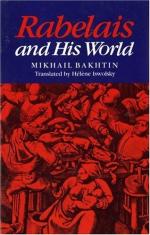
|
| Name: _________________________ | Period: ___________________ |
This test consists of 15 multiple choice questions and 5 short answer questions.
Multiple Choice Questions
1. What are the targets of the abusive language in Rabelais' prologue to the Third Book?
(a) Members of the aristocracy whose political ideals are not in keeping with Rabelais' ideals.
(b) Representatives of old, hypocritical, serious Medieval philosophy.
(c) Foreign travelers who have offended the traditions of Carnival.
(d) Average townsfolk who have imbibed too much wine.
2. In Rabelais' time, the word "drum" and the act of drumming connoted:
(a) Death.
(b) Nature.
(c) Spiritual awakening.
(d) Sexuality.
3. Why does Gargantua steal the bells of the Notre Dame cathedral?
(a) To frighten the townsfolk of Paris.
(b) To decorate the harness of his horse.
(c) To celebrate his marriage.
(d) To sound the alarm for an impending invasion.
4. What does Bakhtin argue is the role of dialogue?
(a) To move the plot along.
(b) To demonstrate thinking out loud.
(c) To oppose the authoritarian word.
(d) To give one character a strong voice.
5. With what portion of the body is grotesque debasement most concerned?
(a) The material lower stratum.
(b) The head and eyes.
(c) The arms and legs.
(d) The spiritual interior essence.
6. How are Bakhtin and Rabelais similar?
(a) They both write mostly novels.
(b) They both directly challenge the government by running for political office.
(c) They both subvert the social prohibition on laughter, satire, and irony.
(d) They live in the same country.
7. Which answer best describes "grotesque realism"?
(a) The writing must strive to be as mathematically or geometrically accurate as possible in its descriptions.
(b) The author's focus must be on bodily gore, blood, death, and dying.
(c) The bodily element is universal, celebratory, positive, and exaggerated.
(d) The tone of the writing is always dark, Gothic, and depressing.
8. During Bakhtin's time, what genre was being closely defined by the Soviet government?
(a) The epic poem.
(b) The biography.
(c) The lyric.
(d) The novel.
9. How does Rabelais accomplish the grotesque degradation of his target in the prologue to the Third Book?
(a) By insulting the targets' mothers.
(b) By declaring the targets to be empty-headed.
(c) By declaring the targets incapable of the basest bodily functions.
(d) By accusing the targets of paganism and crimes against the Church.
10. In the Prologue of the Third Book, to which contemporary events does Rabelais allude?
(a) The Norman Invasion.
(b) The defeat of the French and Spanish fleets by Admiral Nelson.
(c) The Black Death.
(d) The defense of France against Charles V.
11. The combination of solemnity and joking in the tone of the Prologue to the Third Book indicates:
(a) The complex explanation of the Prologue to the readers.
(b) The importance and necessity of laughter.
(c) The confusion the author experiences with this combination.
(d) The opinion that humor must be subordinate to seriousness.
12. What work of literature is parodied in the prologue of _Gargantua_?
(a) Dante's _Divine Comedy_
(b) Malory's _Le Morte d'Arthur_
(c) Chaucer's _Canterbury Tales_
(d) Plato's _Symposium_
13. According to Bakhtin, what is directly related to the oversized foods common at Renaissance feasts?
(a) Bodily restraint as a result of mind over matter.
(b) Grotesque portrayals of the stomach, mouth, and genitals.
(c) The general health of a town's population.
(d) The swelling of religious fervor during holy days.
14. What type of work did Rabelais often publish, especially for the fairs?
(a) Calendars or almanacs.
(b) Political treatises.
(c) Religious tracts.
(d) Biographies of public figures.
15. Bakhtin thinks that life is:
(a) Organized by human acts of behavior and cognition.
(b) A sacrifice the soul makes to the body.
(c) Inert, chaotic, and requiring the intervention of art.
(d) Meaningless and futile.
Short Answer Questions
1. When the grotesque was revived in the Romantic era, what did it react against?
2. "Friar John" is heavily associated with:
3. Curses in Renaissance folk culture tended to focus most closely upon the victim's:
4. How does the Lord of Basche contrive to bring Catchpoles to his castle?
5. What are the "Catchpoles" of which Rabelais writes?
|
This section contains 682 words (approx. 3 pages at 300 words per page) |

|




